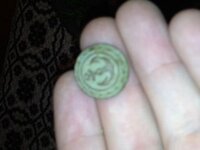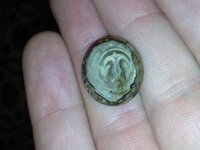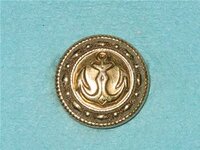pointdlr
Sr. Member
The anchor tells me it is Navy related, and it looks old. Anyone know more? Age? US?
Came off a very old (early 1800's) farm in Ohio.
Thanks,
Jon.
Came off a very old (early 1800's) farm in Ohio.
Thanks,
Jon.






 There were brass two-piece buttons being made by U.S. companies as early as the 1830's or so. During the Rev War, thin brass buttons (almost foil like), were made "two-piece" over a bone back, by British, American, and French manufactures. Furthermore, some of the earliest examples of brass buttons are the solder seamed two-piece, and vent-hole two piece, that pre-date the popular "flat buttons" generally seeing widespread use from 1760-1860.
There were brass two-piece buttons being made by U.S. companies as early as the 1830's or so. During the Rev War, thin brass buttons (almost foil like), were made "two-piece" over a bone back, by British, American, and French manufactures. Furthermore, some of the earliest examples of brass buttons are the solder seamed two-piece, and vent-hole two piece, that pre-date the popular "flat buttons" generally seeing widespread use from 1760-1860. 

 Looking forward to seeing a few pictures of these colonial 2 piece buttons that may be mistaken for mid 19th century 2 piece, merely because I am not familiar with them and willing to learn.
Looking forward to seeing a few pictures of these colonial 2 piece buttons that may be mistaken for mid 19th century 2 piece, merely because I am not familiar with them and willing to learn.  Why else would I be here?
Why else would I be here? 

 I thought for sure I had seen some CW era Naval hat buttons with rusted out backs. My computer is driving me carazy it keeps shutting down and I am constantly editting Im through here
I thought for sure I had seen some CW era Naval hat buttons with rusted out backs. My computer is driving me carazy it keeps shutting down and I am constantly editting Im through here

